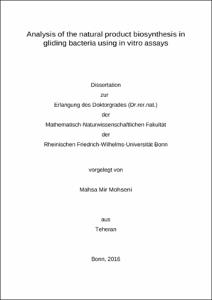Mir Mohseni, Mahsa: Analysis of the natural product biosynthesis in gliding bacteria using in vitro assays. - Bonn, 2017. - Dissertation, Rheinische Friedrich-Wilhelms-Universität Bonn.
Online-Ausgabe in bonndoc: https://nbn-resolving.org/urn:nbn:de:hbz:5n-45540
Online-Ausgabe in bonndoc: https://nbn-resolving.org/urn:nbn:de:hbz:5n-45540
@phdthesis{handle:20.500.11811/7089,
urn: https://nbn-resolving.org/urn:nbn:de:hbz:5n-45540,
author = {{Mahsa Mir Mohseni}},
title = {Analysis of the natural product biosynthesis in gliding bacteria using in vitro assays},
school = {Rheinische Friedrich-Wilhelms-Universität Bonn},
year = 2017,
month = jan,
note = {Natural products are most important in drug discovery and therapy, e.g. more than 80% of antibiotics are derived from microorganisms. Antimicrobial resistance is a global threat and thus an urgent need for new antimicrobial compounds is evident. Gliding bacteria are a unique group of natural product producers, hereto hardly investigated for novel drug-like molecules. The present study focussed on gliding bacteria-derived secondary metabolites. These include the highly halogenated and aromatic ambigols from the cyanobacterium Fischerella ambigua, siphonazole from Herpetosiphon sp. 060, belonging to the Chloroflexi, and corallopyronin A produced by the myxobacterium Corallococcus coralloides B035. The main aim of this investigation was to shed light on the biosynthetic process, especially to determine the starter units for the formation of these metabolites. In addition, in the case of siphonazole biosynthesis, a complete heterologous expression of the siphonazole biosynthetic gene cluster was attempted and the enzymes involved in the synthesis of the terminal alkene moiety were probed. Concerning the cyanobacterial ambigols, 4-hydroxy benzoic acid (4-HBA) was postulated to serve as the precursor in the biosynthetic process.
The DAHP synthases providing the starter unit in the biosynthesis of ambigols and siphonazole were investigated. In addition, in vitro experiments with CorH and CorI shed light on the biosynthesis of the eastern chain of corallopyronin A. Further experiments toward a detailed understanding of siphonazole biosynthesis, either via heterologous expression of the complete gene cluster or through expression of individual protein(domain)s of the terminal part were unfruitful up to now. Therefore, the mechanism leading to the unusual penta-diene terminus is still unsolved and will be subject of future investigations. The present study elaborated a basis for further work on siphonazole biosynthesis, especially the unusual last reaction in the biosynthetic process, since methods for the detection of the decaboxylated and dehydrated final product of the two purified proteins (didomain Hyd-ACP of SphH and TE SphJ) have been established.},
url = {https://hdl.handle.net/20.500.11811/7089}
}
urn: https://nbn-resolving.org/urn:nbn:de:hbz:5n-45540,
author = {{Mahsa Mir Mohseni}},
title = {Analysis of the natural product biosynthesis in gliding bacteria using in vitro assays},
school = {Rheinische Friedrich-Wilhelms-Universität Bonn},
year = 2017,
month = jan,
note = {Natural products are most important in drug discovery and therapy, e.g. more than 80% of antibiotics are derived from microorganisms. Antimicrobial resistance is a global threat and thus an urgent need for new antimicrobial compounds is evident. Gliding bacteria are a unique group of natural product producers, hereto hardly investigated for novel drug-like molecules. The present study focussed on gliding bacteria-derived secondary metabolites. These include the highly halogenated and aromatic ambigols from the cyanobacterium Fischerella ambigua, siphonazole from Herpetosiphon sp. 060, belonging to the Chloroflexi, and corallopyronin A produced by the myxobacterium Corallococcus coralloides B035. The main aim of this investigation was to shed light on the biosynthetic process, especially to determine the starter units for the formation of these metabolites. In addition, in the case of siphonazole biosynthesis, a complete heterologous expression of the siphonazole biosynthetic gene cluster was attempted and the enzymes involved in the synthesis of the terminal alkene moiety were probed. Concerning the cyanobacterial ambigols, 4-hydroxy benzoic acid (4-HBA) was postulated to serve as the precursor in the biosynthetic process.
The DAHP synthases providing the starter unit in the biosynthesis of ambigols and siphonazole were investigated. In addition, in vitro experiments with CorH and CorI shed light on the biosynthesis of the eastern chain of corallopyronin A. Further experiments toward a detailed understanding of siphonazole biosynthesis, either via heterologous expression of the complete gene cluster or through expression of individual protein(domain)s of the terminal part were unfruitful up to now. Therefore, the mechanism leading to the unusual penta-diene terminus is still unsolved and will be subject of future investigations. The present study elaborated a basis for further work on siphonazole biosynthesis, especially the unusual last reaction in the biosynthetic process, since methods for the detection of the decaboxylated and dehydrated final product of the two purified proteins (didomain Hyd-ACP of SphH and TE SphJ) have been established.},
url = {https://hdl.handle.net/20.500.11811/7089}
}






